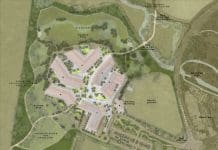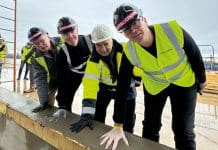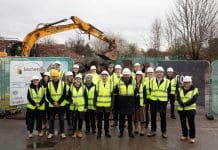Andy Moffat and Danielle Sinnett of the British Land Reclamation Society summarise how land reclamation, or brownfield development, can be used to address a housing shortage, returning land into ‘beneficial use’…
The term land reclamation is less used these days than it was in the last decades of the twentieth century. This is possibly because of the considerable advances in the reclamation of coal tips and other mineral sites during this time. In the 1980s a reasonable definition might have been ‘returning disturbed land to beneficial use’ and much of the land in question was reclaimed to agriculture, forestry or amenity use. This was complemented towards the turn of the century by the marked increase in housing development on brownfield land, which embraces the types of land mentioned above but also includes disused or derelict land previously used for industrial, commercial or residential purposes. And now with a severe national housing shortage, we are once again focused on housing as the beneficial use for such land.
Given this state of affairs, what is the modern role for land reclamation, and to what extent is the reclamation profession actively supporting or hindering ambitions, expressed so formally in the Barker review (2003, 2004), and the recent government announcements to build on brownfield land? What are the constraints to building on brownfield land and are technical issues getting in the way of progress in house construction?
Firstly, it’s worth reiterating that there are some compelling reasons for redeveloping brownfield land. Much of brownfield land is ugly and some is dangerous. Unchecked, unreclaimed brownfield land can reinforce multiple deprivation and social inequality. A great deal of brownfield land is integrated in the fabric of towns and cities so it makes sense to return it to one of their principal functions – i.e. providing places to live. New homes can thus tap into existing infrastructure, such as public transport, schools and hospitals. A study for CPRE1 last year identified brownfield land in England sufficient for nearly one million homes!
The old arguments against building on brownfield land perhaps need repeating too: that greenfield land is cheaper and less risky for investors. In contrast, brownfield land is often perceived as contaminated or containing obstructions due to existing or pre-existing buildings and these factors can act as powerful disincentives to investment. These will require remediation which may be costly, and together with residual liability issues promotes uncertainty and lack of confidence in investment.
However, let’s look at this afresh. Firstly, new research2 has shown convincingly that there are many other reasons why brownfield land isn’t snapped up for housing. These include: perception of crime; under-skilled labour force; difficulties in site assembly; inadequate access; ownership patterns; uncertain demand; challenges in obtaining financial support; overlapping jurisdiction; and aging urban infrastructure. The current recession has also been implicated and other recent research in Nottingham3 has shown that the most frequently occurring significant constraint to development was poor market conditions.
And speaking for reclamationists, we can point to well tried and tested methodologies for brownfield land redevelopment. Firstly, the terms ‘brownfield’ and ‘contamination’ are NOT synonymous – for smaller sites, perhaps only about one quarter of brownfield land suffers from contamination to an extent that some form of remediation is required.
For the quarter that is affected, the Code of Practice for exploration of potentially contaminated sites (BS10175: 2011) prevents wasteful expenditure in site investigation. And the National House Building Council, Environment Agency and Chartered Institute of Environmental Health have produced useful guidance on safe development of housing on such land4. Of course there are sites, often the larger ones, where previous industrial use indicates the necessity of more significant reclamation. However, it is now fifteen years since the contaminated land regime under Part 2A of the Environmental Protection Act 1990 came into force, and there are many proven remediation technologies to select from. This gives developers much more control about how to regenerate a contaminated brownfield site, with commensurate financial advantage. But for many sites remediation will not be necessary, and more conventional reclamation strategies can be used.
Vertical development in much modern town and city centre brownfield redevelopment is unlikely to involve significant creation of gardens or allotments with attendant risk of contaminant transfer through growth of foodstuffs. However, the importance of urban green infrastructure for other goods and services such as sustainable urban drainage, shade and recreation is increasingly recognised. In these cases, possible contaminant exposure can be prevented by judicious design and use of clean cover materials. Reclamationists are expert in selection of soil materials for appropriate after-use(s) and are increasingly drawing upon skills in clean soil manufacture using widely available and specified compost materials. Indeed, these may be more reliable than seeking to remediate contaminated soils themselves.
Let’s not forget reclamation of brownfield land previously used for mineral extraction – for example the Ebbsfleet site where a new ‘garden city’ is planned is on an ex chalk quarry. There is much experience in redevelopment of these kinds of sites for housing and some exemplary completed projects around the country. Such brownfield sites offer considerable flexibility for innovative design including incorporation of green infrastructure and adherence of sustainability principles.
It’s worth mentioning that some conservation groups regard brownfield land as better unreclaimed in order to support particular species of plants or animals. The recognition of the ‘open mosaic habitat’ estimated to be associated with about 8% of brownfield land can threaten its development for housing where it occurs. Reclamationists understand that wildlife can thrive in some of these circumstances and are not averse to protection of biodiversity. However, it should be recognised that urban brownfield land is a precious commodity for regeneration of towns and cities, and such habitats often represent a temporary form of land-use before renewed interest to convert it once more ‘for beneficial use’. Land reclamation remains a vital profession to support the current policy of creating housing on brownfield land, and one which is likely to remain with us as long as we face increasing housing demand. Reclamationists traditionally ‘see the big picture’ and can support new housing development from a wide range of positions. They tend to work across traditional disciplines and thus integrate soil science, engineering, hydrology, ecology and planning. ■
2 http://dx.doi.org/10.1016/j.habitatint.2014.06.028
3 http://dx.doi.org/10.1108/JERER-07-2015-0029
4 http://www.nhbc.co.uk/NHBCPublications/LiteratureLibrary/Technical/filedownload,33630,en.pdf
. . . . . . . . . . . . . . . . . . . . . . . . . . . . . . . . . . . . . . . . . . . . . . .
Andy Moffat
Chair
BLRS (British Land Reclamation Society)
A J Moffat & Associates
Danielle Sinnett
Senior Research Fellow
Centre for Sustainable Planning and Environments
University of the West of England
















